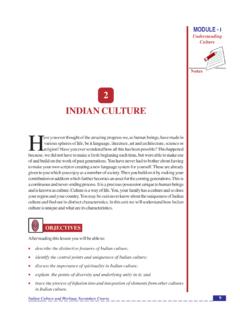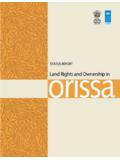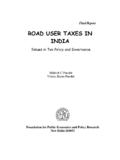Transcription of LAND USE AND Notes AGRICULTURE
1 MODULE - 8 Economic activitiesand infrastructuraldevelopment in IndiaNotes 125 land use and AgricultureGEOGRAPHYIn the previous lessons, we studied climate, soils, various types of resources andhuman activities. In this chapter, we will study AGRICULTURE . For AGRICULTURE , land isa very important resource. For its large area size, and physical and socio-culturaldiversities, India has different types of landuses. AGRICULTURE is predominant eco-nomic activity in India, engaging nearly three-fifths of its working population. Thoughthe share of agricultural sector in gross domestic product has considerably de-clined to about one-fourth yet the importance of AGRICULTURE as employment pro-vider to workforce especially in the countryside is very high. Obviously, agricul-ture forms the hub of Indian economy as a large number of industries are alsoheavily dependent on AGRICULTURE for supply of raw materials.
2 AGRICULTURE involvesnot only crops raising but also animal ranching and fishing. OBJECTIVESA fter studying this lesson, you will be able to: know the availability of land in India and its different uses; appreciate the significance of studying land use and AGRICULTURE ; examine various factors responsible for the development of AGRICULTURE inIndia; describe the different types of crops grown in various parts of India; locate and identify the areas under different crops on a map of India; infer changing pattern of crop cultivation; explain the concept and significance of Agro-climatic Regions; identify the different strategies adopted for the agricultural development inIndia, during five year plans and explain the impact of economic liberalisation on AGRICULTURE in USE ANDAGRICULTUREMODULE - 8 NotesLand use and AgricultureEconomic activitiesand infrastructuraldevelopment in India GENERAL land USELand is the most vital resource of a country.
3 It is a fixed asset and cannot beexpanded to meet the needs of an increasing population. Therefore, it mustbe used carefully and in the best possible manner. The total geographicalarea of India is lakh sq. kms. The major landuses in India are:Net Sown Area (NSA)The total land area on which crops are grown in a region is called net sown net sown area and the area sown more than once together are called grosscultivated area. In India, about 47 per cent of total reporting area is under thenet sown namely Punjab, Haryana, West Bangal, Uttar Pradesh, have the highproportinal share of NSA than the national average. Against this, the shere ofNSA is less than one half of the national average in states of Himachal Pradesh,Uttarakhand, Meghalaya, Manipur, Nagaland, Mizoram, Sikkim and ArunachalPradesh.
4 All these states suffer from physical disabilitis such as undulating terraindue to hilly topography, limiting the availability of plain land and fertile soils, impor-tant for cultivation. This is evidently clear from state wise distribution of propor-tional share of NSA that physiographic factors play an important role in availabil-ity of net cropped area in a area under forest cover is about 68 million hectares or 22 per cent of the totalarea in the country. This area has increased from 40 million hectares in 1951 to 68million hectares in 2000. For the ecological balance the forest cover should be atleast 33 per cent of the total geographical area of a country. The states of ArunachalPradesh, Mizoram, Jammu & Kashmir and Tripura have relatively larger propor-tion of area under forest Not Available for CultivationThe land under the settlements, roads, mines and quarries along with barren landsare included in this category.
5 The sandy waste land of Rajasthan, marshy land ofKutchh (Gujarat) and rugged and eroded areas of northeast and northern moun-tains are few examples of barren lands. About 13 per cent of the total reportedarea is recorded under this category. Nagaland, Manipur and Assam registered avery high percentage of area not available for LandsWhen lands are left unused to regain their lost fertility in a natural way is calledfallow land . On the basis of usability criteria follow lands can be divided into twogroups current and old. Current fallow is the land in which no crop is raised duringthe current year. Old fallow land remain unused for a period of one or more yearsMODULE - 8 Economic activitiesand infrastructuraldevelopment in IndiaNotes 127 land use and AgricultureGEOGRAPHYbut not exceeding 5 years.
6 This is due to low investment capacity of numeroussmall and marginal farmers in advanced technology, lack of awareness, loss offertility of soil, inadequacy of rainfall, lacking in irrigational facility etc. The fallowland occupy about per cent of the total reported area. The states of Mizoram,Tamil Nadu, Meghalaya, Bihar, Andhra Pradesh and Rajasthan have a high per-centage of area under fallow land . It is to be noted here that old fallow land maynot be economically important but from ecological point of view fallow land isimportant category of WasteIt is the land in which crops were raised for some period of time but has not beencultivated for the last five years due to certain deficiencies such as alkalinity andsalinity in the soils. Such cultivable waste are locally known as reh, bhur, usar,and khola in the some part of North India.
7 Maghalaya, Himachal Pradesh andRajasthan have a very high share of cultivable waste land in total land use in re-spective Pastures and Grazing LandsNot withstanding the highest live stock population in the world, India has only lessthan 4 per cent of the country under pastures and grazing lands. The states ofHimachal Pradesh, Karnataka, Madhya Pradesh, Maharashtra, Gujarat andRajasthan have high above 5% of area under this area under different landuses are given below (Table )Table : land Utilization in IndiaLandusesArea (in lakhs hectare)In under and uncultivable area tree waste pastures landTotal3049*100* Total geographical area of which land utilization data is - 8 NotesLand use and AgricultureEconomic activitiesand infrastructuraldevelopment in India AGRICULTURAL land USEThe net sown area, current fallows and land under tree crops and groves areincluded in agricultural land use.
8 The agricultural land in India is little more than 50per cent of the total geographical area in the country. This is the highest share ofland in any country in the world. But due to large size of population in India, percapita arable land is available only hectares, which is lower than the worldaverage ( hec). The per capita agricultural land in some select countries ismuch higher than India. In Australia it is hec., in Canada and in hec. The lower per capita availability of land is an indicator of high pressureof population on land resources. Since there is little scope for increasing landunder the plough, the way out to feed the growing population can be found inincreasing land productivity. Over the period, area sown more than once has beenincreasing which is about 15 per cent.
9 If the same piece of land is sown more thanonce in a year, it is called cropping intensity. Which stands for the ratio betweengross cropped area and net sown use of new technology, fertilizers,good quality of seeds and irrigation facilities are necessary for increasing intensityof cropping. The so called Green Revolution is also nothing but technologicalpackage, which include HYV seeds, chemical fertilizers and artificial the adoptation of Green Resolution by India in 1966 onwards agricultural, land use has undergone a significant TYPES OF FARMINGThe basis for the classification of different types of AGRICULTURE in India are rainfall,irrigational facilities, purpose of production, ownership and size of holding andtechnology used. On the basis of these factors a number of farming can be identi-fied.
10 The main types of farming in India are:A. Dry FarmingThis type of farming is practised in the areas where the amount of annual rainfall isgenerally less than 80 cms. In such regions, the farmers are generally dependentupon rainfall. Here, moisture content in the soil is less. Hence, only one crop canbe grown in a year. Millets like jawar, bajra, ragi, pulsees etc. are important cropsgrown under this type of farming. Rajasthan, Maharashtra, parts of MadhyaPradesh, Southern Haryana, part of Gujarat and Karnataka fall under this cat-egory of farming. In such areas, farmers adopt subsidy activities such as dairy,cattle farming to supplement their meagre farm Wet FarmingThis type of farming is practised in the areas of alluvial soils where annual averagerainfall is more than 200cm.

















